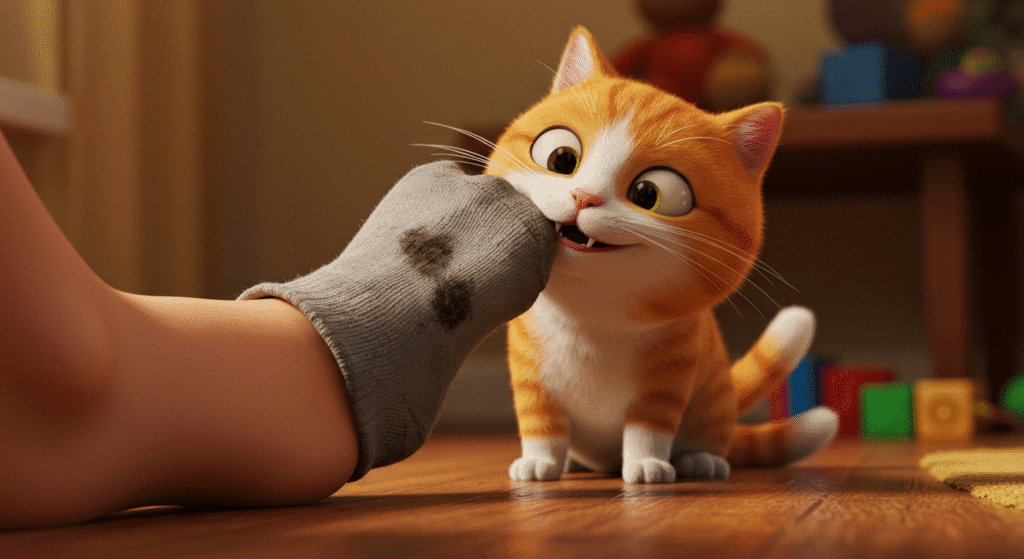We’ve all been there. You hear that dreaded sound in the middle of the night—the slow, deliberate scrape of a paw against surface, followed by the crash of another prized possession meeting its untimely end on your floor. Your cat sits at the crime scene, looking not guilty but oddly… satisfied?
This seemingly destructive behavior isn’t just your feline friend waging psychological warfare on your belongings (though it might feel that way at 3 AM). There’s fascinating science behind why your cat can’t resist the urge to send your stuff flying.
The Science of the Swipe
Cats are natural-born scientists. When your kitty pushes your favorite mug off the counter, they’re actually conducting gravity experiments that would make Newton proud. Here’s what’s really happening:
Hunting Instincts at Work: In the wild, cats paw at potential prey to test if it’s alive. Your stationary knickknack doesn’t react? Better give it another tap… and another… until—oops!—it plummets to the floor.
Cause and Effect Learning: Cats are curious about how things work. What happens when I touch this object? It moves! What happens if I push harder? It falls! The crash creates an exciting result that rewards their curious brain.
Attention-Seeking Behavior: Notice how quickly you come running when something breaks? Your cat certainly has. When they’re bored or want interaction, they’ve learned that creating a commotion gets results.
Tactile Exploration: Cats’ paws are incredibly sensitive instruments. They use them to literally feel out their environment, sometimes inadvertently sending objects on a one-way trip to the floor.
Why Your Reaction Makes It Worse
That exasperated sigh or frantic dash to clean up the mess? That’s the equivalent of a standing ovation to your cat. Even negative attention is still attention, and your reaction reinforces that pushing things equals human interaction.
Some cats even learn to make direct eye contact while slowly, deliberately nudging your treasured possessions closer to the edge—a clear sign they’re connecting your reaction to their behavior.
Prevention Strategies That Actually Work
Instead of constantly picking up pieces of broken ceramics, try these proactive approaches:
- Strategic placement: Keep precious items away from edges and out of paw’s reach
- Environmental enrichment: Provide plenty of toys and stimulation so they’re less likely to create their own entertainment
- Positive redirection: When you catch them contemplating a swipe, engage them with a toy instead
- Museum putty: This removable adhesive can secure items to surfaces without damaging them
- Clicker training: Yes, you can train cats! Reward them for positive behaviors around your belongings
The Cat Physicist’s Workbench: An Interactive Activity
Want to satisfy your cat’s inner scientist while protecting your valuables? Create a designated “pushing zone” where it’s actually okay for them to explore gravity:
Materials needed:
- A shallow cardboard box or tray with raised edges
- Various cat-safe objects of different weights and textures
- A waterproof mat to place underneath
Setup:
- Place the box on a stable surface that’s comfortable for your cat to access
- Arrange the objects inside the box
- Introduce your cat to their new “physics lab”
- Observe which items they prefer to interact with
This controlled environment allows them to indulge their natural pushing behavior while containing the chaos. Pay attention to patterns—do they prefer lightweight objects? Things that make noise? Understanding their preferences can help you better cat-proof your home.
The Personality Behind the Push
Interestingly, some cats are more prone to this behavior than others. Researchers have identified distinct feline personality types, with more active, curious cats being the most likely offenders. Your particular tabby troublemaker might score high on openness to experience and extraversion—the feline equivalent of a thrill-seeker!
Some experts even suggest that cats who regularly push objects show higher intelligence, as they’re demonstrating advanced cause-and-effect understanding. So while you’re sweeping up the remains of your coffee mug, you can at least take pride in your cat’s cognitive capabilities.
The Silver Lining
This maddening behavior actually reveals something rather endearing about our feline friends. In their naturally solitary world, they’ve evolved to be curious, independent problem-solvers. When they push objects off surfaces, they’re displaying the very qualities that helped their ancestors survive—intelligence, curiosity, and adaptability.
Plus, there’s something undeniably entertaining about watching a cat fully committed to the scientific method, even if your belongings are the experimental subjects.
So the next time you witness your cat calculatingly pushing your pen toward the edge of your desk, try to appreciate the complex little mind at work. They’re not being malicious—they’re being cats, exploring their world in the most direct way they know how.
And maybe keep your grandmother’s antique vase in a cabinet, just to be safe.



